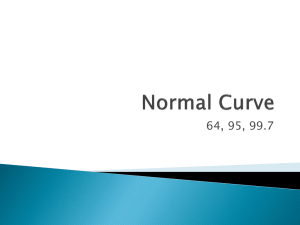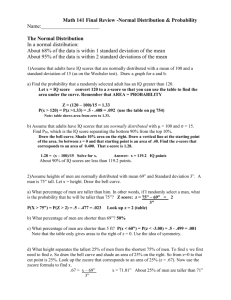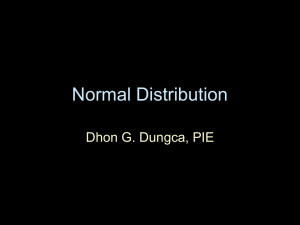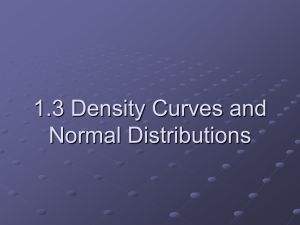Z-Score Investigation
advertisement
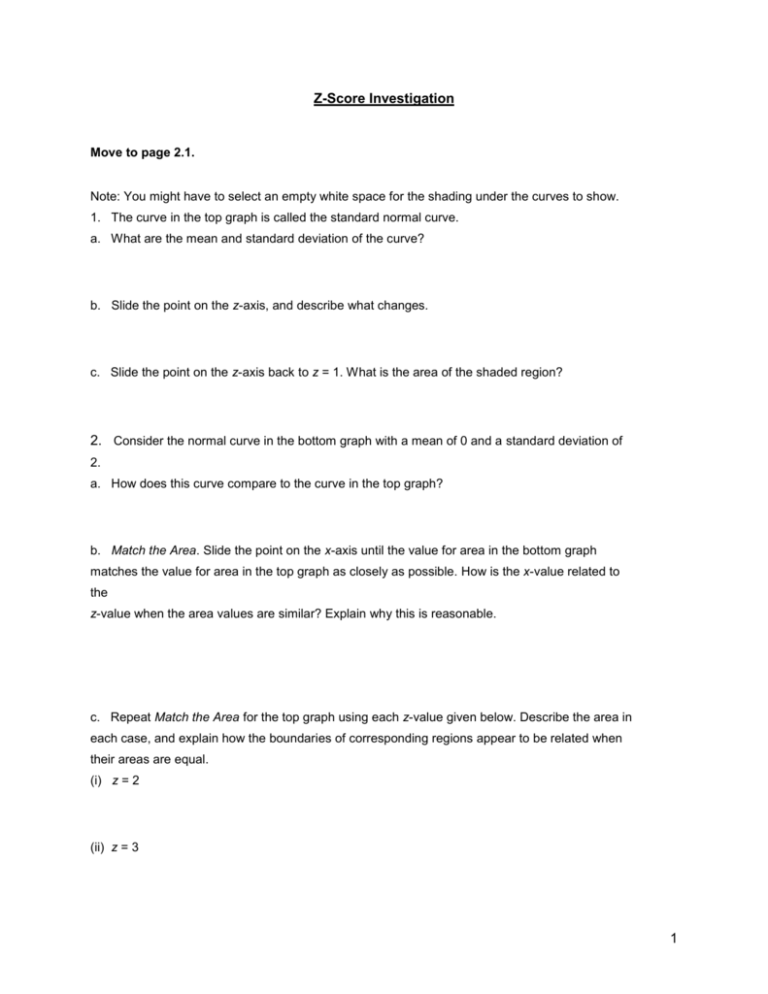
Z-Score Investigation Move to page 2.1. Note: You might have to select an empty white space for the shading under the curves to show. 1. The curve in the top graph is called the standard normal curve. a. What are the mean and standard deviation of the curve? b. Slide the point on the z-axis, and describe what changes. c. Slide the point on the z-axis back to z = 1. What is the area of the shaded region? 2. Consider the normal curve in the bottom graph with a mean of 0 and a standard deviation of 2. a. How does this curve compare to the curve in the top graph? b. Match the Area. Slide the point on the x-axis until the value for area in the bottom graph matches the value for area in the top graph as closely as possible. How is the x-value related to the z-value when the area values are similar? Explain why this is reasonable. c. Repeat Match the Area for the top graph using each z-value given below. Describe the area in each case, and explain how the boundaries of corresponding regions appear to be related when their areas are equal. (i) z = 2 (ii) z = 3 1 Move to page 3.1. 3. The top graph on this page is a copy of the top graph on page 2.1 but with z = 1.0. The bottom graph on this page is the normal curve with a mean of 0 and standard deviation controlled by the slider s. a. Adjust the slider so that the standard deviation is 1.5, and play Match the Area again. How is the x-value you obtained related to the z-value shown in the top graph? b. Repeat Match the Area in the top graph using each z-value below. Compare your answers to those you found in Question 2, part c. (i) z = 2 (ii) z = 3 4. Repeat Match the Area with several more choices for s. Summarize your conclusions about the relationship between corresponding boundary values and standard deviations. Move to page 4.1. 5. This page shows the standard normal curve (top) and a normal curve with the mean controlled by slider m and the standard deviation controlled by slider s (bottom). a. Adjust the sliders so that the mean is 1.5 and the standard deviation is 1. Describe as carefully as possible how the top and bottom graphs are related. b. Based on your description in part a, predict the value for the right-hand boundary of the shaded region in the bottom graph when the area is as close as possible to 0.683 square units. Slide the right endpoint to verify your prediction. Explain why this makes sense. c. Repeat Match the Area with the same settings for m and s as in part a, using the z-values given below in the standard normal curve. In each case, how far is the final right boundary from 2 the mean? (i) z = 2 (ii) z = 3 6. Adjust the mean and standard deviation sliders to values of your own choosing. For each new setting, predict the right endpoint values of x needed to obtain equal areas when the endpoints of the top graph are z = 1, z = 2, and z = 3. a. Explain how you obtained your predicted values. Play Match the Area to verify your prediction. b. What is the relationship among the shape of the normal curve, the standard deviation of the curve, and the boundary lines for areas within 1, 2, and 3 standard deviations from the mean? 7. Summarize the results of your work thus far. Be sure to specify particular values of area and associated boundaries and how these relate to the mean and standard deviation of the distribution you are investigating. Do this as a class on the Z-Score vocab/notes sheet. 8. a. If you know the right boundary line at 6.5 for a normal curve is 2 standard deviations above the mean and the left boundary line at –4.5 is 2 standard deviations below the mean, explain how you would find the mean. b. What is the area between the two boundary lines in part b? 9. Using an area of 0.451 square unit, repeat Match the Area. a. Identify the z-value for the right boundary line in the standard normal curve, and explain what it tells you about the location of the boundary line. 3 b. For a mean of 0.5 and a standard deviation of 2.5, find the right boundary line in the curve in the bottom graph that would give an area of 0.451 square unit. How are the mean and standard deviation related to the boundary lines in the standard normal curve? c. Choose a new m and s. Answer the questions in part b again. d. Choose a new area, and answer the questions in parts a through c again. 10. Summarize the results of your explorations. In your summary, include details of how corresponding distances to the mean are related and a formula for finding the boundary lines. 4


